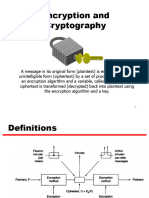0% found this document useful (0 votes)
31 views31 pagesCryptography and CryptoSystems
The document is a project on cryptography by Joyash Shrestha, covering its history, features, types, and applications in securing data. It explains the basic concepts of encryption and decryption, the differences between symmetric and asymmetric cryptography, and the importance of cryptographic techniques in modern communication. The project serves as an introduction to cryptography and highlights its relevance in everyday life.
Uploaded by
karkireo567Copyright
© © All Rights Reserved
We take content rights seriously. If you suspect this is your content, claim it here.
Available Formats
Download as PDF, TXT or read online on Scribd
0% found this document useful (0 votes)
31 views31 pagesCryptography and CryptoSystems
The document is a project on cryptography by Joyash Shrestha, covering its history, features, types, and applications in securing data. It explains the basic concepts of encryption and decryption, the differences between symmetric and asymmetric cryptography, and the importance of cryptographic techniques in modern communication. The project serves as an introduction to cryptography and highlights its relevance in everyday life.
Uploaded by
karkireo567Copyright
© © All Rights Reserved
We take content rights seriously. If you suspect this is your content, claim it here.
Available Formats
Download as PDF, TXT or read online on Scribd
/ 31





















































































